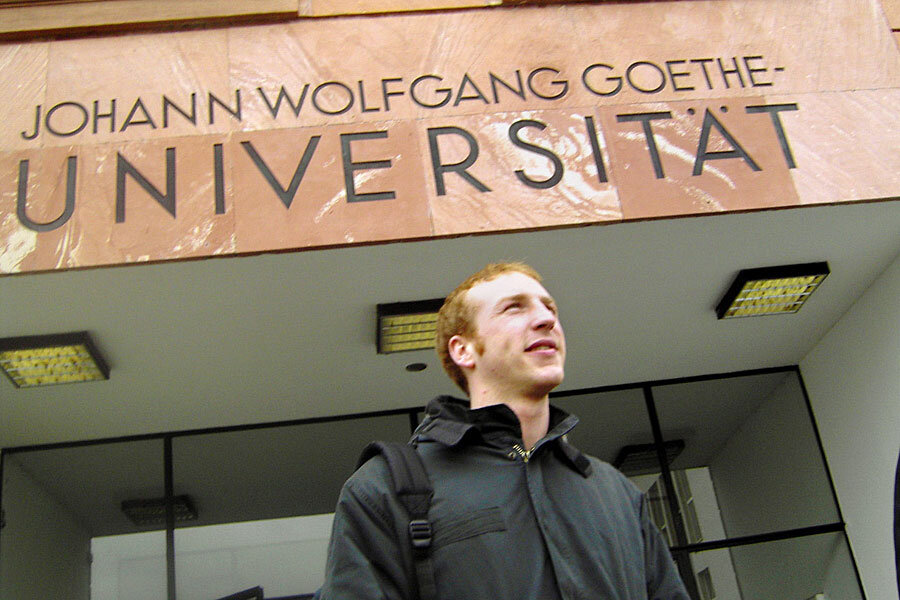Free college in Europe: An attractive option, but not for everyone
Loading...
Just a couple of years ago, the most popular reason to move abroad was to escape taxes. More and more, cheap – and even free – college tuition is becoming an enticing factor for young Americans to move abroad.
In a survey conducted last year, more than a third of American respondents said they would consider moving out of the country. Nearly half, or 48 percent, cite educational opportunities as the major incentive. And a small but rising number of American students have made the move – in 2012, there were 47,000 college students getting their degrees outside of the US.
According to Peggy Blumenthal, the senior counselor to the president at the Institute of International Education, about half are post-grad students and the other half are undergrads – "a growing trend, though it's still a niche," she tells The Christian Science Monitor.
But even free college tuition comes with its own invisible set of costs, and for many low-income students, traveling across the Atlantic isn’t exactly the most viable option.
"Whether you're the child of a doctor, lawyer or garbage man, you'll have the same opportunity and the same education here,” Hannah Remo, an American student currently studying at the Hague University in the Netherlands, told CNN Money’s Katie Lobosco.
By “here,” she’s not talking about the US.
According to Beyond the States, an organization that connects students in the US with educational opportunities abroad, there are more than 300 schools in Europe offering over 1,500 bachelor’s programs taught in English. All of these programs are at least 20 percent cheaper than the average cost of tuition in the US. And out of the 300 institutions, at least 44 in countries like Norway, Germany, Finland, and Iceland are completely free for international students.
The majority of colleges in Europe charge less than $2,225 a year, Beyond the States’ founder Jennifer Viemont told CNN.
Here in the states, the 2015-2016 list price for public universities cost an average of $9,410, not including room and board. At private institutions, it’s $32,405. But taking scholarships and financial aid into account, the average price falls to under $4,000.
“The premise of free college in Europe seems a little misleading,” Adela Soliz, an education fellow at the Brookings Institution, tells The Christian Science Monitor. “People are comparing free to the list prices of colleges, but if you look at the net price of college, it’s much lower.”
How much students can save by going abroad for college, it turns out, is a case-by-case calculation.
"This is a perfect option for middle, upper-middle class families whose children don’t need the substantial financial aid that many Americans that rely on to get through college," Ms. Blumenthal says.
For Ms. Remo, the Hague University certainly isn’t much cheaper than the highest she would’ve paid for public school in the US, but the Dutch lifestyle and culture make up for it.
“I disagree with the way a lot of things are run at home,” she said. “It blows my mind that college is so expensive in the US, it makes me think that I don't want to raise a family there."
But moving abroad isn’t a feasible option for every cash-strapped college student in America. Transcontinental airfare can cost up to thousands of dollars, especially accounting for visits home during holidays. A round-trip ticket to Amsterdam alone is more than $1,000.
And the degree itself isn’t without shortcomings. Beyond the culture gap and lack of immediate support, foreign degrees may not be as valuable for work in the US as domestic ones. The alumni network may also be much smaller outside of the international colleges’ home countries.
“A big potential disadvantage is partly a branding issue,” Ms. Soliz says.
“Potential employers are responding to a name [of an institution] on a CV,” she explains, so if they see Harvard, or Ohio State University, they have a general impression of that institute and its alums.
Ms. Blumenthal adds that because education tends to be more hands-off in Europe, the ideal student would be someone who's more self-sufficient. Not to mention, working in foreign countries often require special visas that students cannot obtain, which means that room and board will have to be paid out of pocket. So for the most underprivileged college students, then, the best options may be at home.
“Of course college is still very unaffordable in the US, but there’s also a lot of financial aid that’s left on the table,” Soliz says.
In the 2014-2015 school year, full-time undergraduate students received an average of $14,210 in financial aid each, totaling $238.9 billion in grants. While 37 percent of that money comes from the federal government, more than 40 percent can be attributed to colleges and universities themselves.
Top-tier schools, such as Columbia and Duke, are free for students in families that make less than $60,000, and local programs like Tulsa Achieves offers high-school graduates with C-averages, who are willing to do community service, full-ride scholarships to regional community or state colleges.
Still, depending on personal resources, the foreign college savings may be better than taking on student debt in the US.
Hunter Newsome, for instance, would’ve spent close to $14,000 a year at the University of California, Davis. But instead, it costs him less than a quarter of that to study at the Tallinn University of Technology in Estonia. And rent is only $256 per month.
"It was my Dad's idea and I thought, why the hell not?” Mr. Newsome, who studies international relations, told CNN Money. “My mom was skeptical at first but she started researching and found out it was going to be a lot cheaper."






